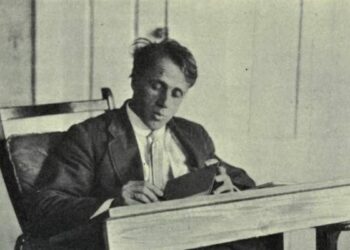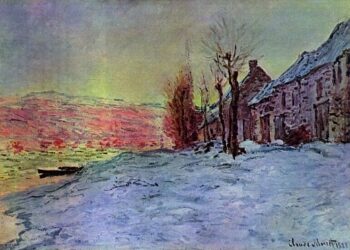To Any Reader Poem Summary By Robert Louis Stevenson
To Any Reader Poem Summary
- As from the house your mother sees
- The speaker begins by addressing the reader, suggesting a scenario where a mother observes something happening from her house.
- You playing round the garden trees,
- The speaker imagines the reader, perhaps a child, playing around trees in a garden.
- So you may see, if you will look
- The speaker suggests that just as the mother observes the child, the reader can observe something too if they pay attention.
- Through the windows of this book,
- The book is likened to windows through which the reader can perceive something.
- Another child, far, far away,
- The speaker introduces the idea of another child, distant from the reader.
- And in another garden, play.
- This distant child is playing in another garden, emphasizing the vastness of the world and the variety of experiences.
- But do not think you can at all,
- The speaker advises the reader not to assume they can fully comprehend or know everything.
- By knocking on the window, call
- The metaphorical window represents the barrier between different experiences, and the speaker suggests that simply observing is not enough.
- That he will hear your crying small,
- The reader is cautioned that their attempts to connect may not be heard or understood by the distant child.
- For the sound is dead in that clear air,
- The speaker uses the imagery of clear air to suggest a sense of distance and separation.
- Like footless faeries, unaware
- The sound is compared to footless fairies, reinforcing the idea that the cry may go unnoticed in the vastness.
- Of humankind, he does not know
- The distant child may be unaware of the existence and experiences of the reader.
- His danger or your pain or woe.
- The speaker acknowledges the potential difficulties or dangers faced by the distant child but suggests that they are unaware of the reader’s concerns.
- He is engrossed in what he plays:
- The distant child is fully absorbed in their own world and activities.
- This is the world that he portrays.
- The activities of the distant child are like a portrayal of their world.
- And here at noon, and there at prime,
- The speaker refers to different times of the day in different locations.
- Baby, in another’s nursery rhyme.
- The distant child, like a baby, is part of someone else’s story or world.
- Think it not hard if you should find
- The reader is advised not to be disheartened if they come to realize.
- Such doings in your daily grind;
- That similar activities or experiences occur in their own daily life.
- You still have bread and fire and song,
- Despite the different experiences, the reader is reminded of the simple and essential things in life: sustenance, warmth, and music.
- And place to sit and rest a bit.
- The reader is encouraged to appreciate the comforts of life, such as having a place to sit and rest.
- Content you with this thing at least—
- The speaker advises contentment with at least this basic understanding.
- That, though much out, you are not lost
- Even if the reader feels distant or disconnected, they are not entirely lost or without direction.
- And though by no means clearly crossed
- The path may not be entirely clear.
- And often in the twilight tossed.
- The reader may feel uncertain and tossed about in the metaphorical twilight of understanding.
- Life is a gift you have not lost,
- Life itself is emphasized as a valuable gift.
- For all this strife and all this play.
- Despite the challenges and varied experiences, life is a combination of struggles and pleasures.
- And you may see, if you will look
- The speaker repeats the idea that the reader can perceive something significant.
- Through windows of this tale-book,
- Similar to earlier, the book is likened to windows through which the reader can gain insight.
- Another child, far, far away,
- The cycle is repeated, emphasizing the universality of experiences.
- And in another garden, play.
- Another child is playing in another garden, underscoring the vastness and diversity of life.
Also Read-
- The Swing Poem Summary Line by Line
- The Land of Story-Books Poem Summary By Robert Louis Stevenson
- My Shadow Poem Summary line by line
To Any Reader Poem
Conclusion:
To Any Reader by Robert Louis Stevenson invites readers to reflect on the intricate tapestry of human experiences and the vastness of life. Through the metaphor of observing a child in a distant garden, Stevenson emphasizes the unique and diverse nature of individual lives. The poem encourages the reader to appreciate the simple pleasures, find contentment in their own circumstances, and recognize the universality of certain human experiences. Despite the potential distance between individuals, Stevenson suggests that common threads connect us all.To Any Reader Poem Summary By Robert Louis Stevenson
The poem serves as a gentle reminder to cherish the present, be content with life’s essentials, and acknowledge the shared humanity that binds us together.To Any Reader by Robert Louis Stevenson,To Any Reader by Robert Louis Stevenson: poem analysis,
FAQs:
1. Who is the author of “To Any Reader”?
“To Any Reader” is a poem written by Robert Louis Stevenson, a Scottish author known for his works such as “Treasure Island” and “Strange Case of Dr Jekyll and Mr Hyde.”
2. What is the central theme of “To Any Reader”?
The central theme revolves around the diversity of human experiences and the interconnectedness of individuals. The poem encourages readers to find contentment in their own lives while recognizing the common threads that bind humanity.
3. Why does the poem use the metaphor of a child in a distant garden?
The metaphor of a child in a distant garden represents the idea that each person has their own unique experiences and life path. It emphasizes the vastness of life’s tapestry and the potential distance between individuals.
4. What is the message about life in “To Any Reader”?
The poem conveys a message of appreciation for life’s diversity, the importance of finding contentment in simple pleasures, and the recognition of shared humanity despite individual differences.

















